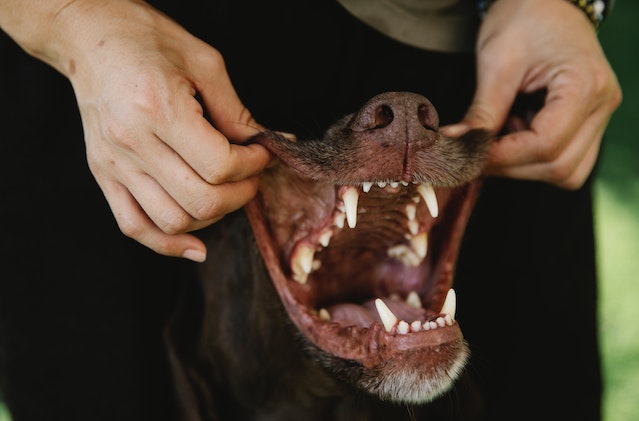You’ve always seen your dog with an open mouth. You probably notice his teeth every day, but have you ever wondered if all these teeth are the same or different?
There are two sets of teeth in a dog: 28 deciduous or milk teeth and 14 permanent teeth. By the time puppies are six to seven months of age, their milk teeth are also replaced by permanent teeth. So, an adult canine has 42 teeth, 20 upper (Maxillary) and 22 lower (Mandibular). These 42 adult teeth are of four types: incisors, canines, premolars, and molars.
To learn more about these tooth types in dogs, see our dog dental chart in the next section. We’ll be discussing the anatomy of each tooth type and its purpose. So, let’s begin!
Dog Dental Chart
Before we begin with the dog teeth chart, there are a few things to keep in mind.
42 teeth in dogs are numbered according to the modern Triadan System. According to this system, each tooth is given a three-digit number (for example, 101). The first digit denotes one of the four quadrants of the mouth in which the tooth is lying: right maxillary, left maxillary, right mandibular, and left mandibular.
- If it is 1, it means the tooth is right and upper/maxillary.
- If it is 2, it means the tooth is left and upper/maxillary.
- If it is 3, it means the tooth is left and lower/mandibular.
- If it is 4, it means the tooth is right and lower/mandibular.
For deciduous teeth, the number continues up to 8 in the same manner.
The other two digits in the tooth number define the tooth’s position, starting from front to back. So,
- 01, 02, and 03 are incisors.
- 04 are canines.
- 05, 06, 07, and 08 are premolars.
- 09, 10, and 11 are molars.
The Adult Dog Dental Chart
| Tooth type | Right Maxillary | Left Maxillary | Left Mandibular | Right Mandibular |
| Incisor | 101, 102, 103 | 201, 202, 203 | 301, 302, 303 | 401, 402, 403 |
| Canine | 104 | 204 | 304 | 404 |
| Premolar | 105, 106, 107, 108 | 205, 206, 207, 208 | 305, 306, 307, 308 | 405, 406, 407, 408 |
| Molar | 109, 110 | 209, 210 | 309, 310, 311 | 409, 410, 411 |
4 Types of Dog Teeth: Anatomy and Purpose

1. Incisors
Incisors are flat small teeth in dogs that have the shape of a chisel. They are present at the front of the canine mouth. They are 12 in number, six maxillary, and six mandibular. The dogs use these teeth for nipping and biting. The pointed edges of these flat teeth help them scrape the meat from the bones. These are also used by dogs for grooming themselves and for removing any insects from their coats.
2. Canines
These are the long pointed fangs present anteriorly in a dog’s mouth. These are the first to be visible when the dog opens its mouth. Canine teeth are the characteristic feature of a dog, due to which dogs are also called “canines”. Dogs have four canines in total, two upper and two lower. Due to their sharp surfaces, these teeth are used by dogs to tear meat and puncture things. Dogs also use their canines to grip something in their mouths. During games, they use these teeth to hold on to balls, ropes, and toys.
3. Premolars
Premolars are flat and wide teeth that are present behind the canines. They are 16 in number, out of which eight are present on top and eight on the bottom. Due to their flat surfaces, these are used by dogs for shearing and crushing something harder. Dogs rarely chew their food, but when they do, they use their premolars. They also use them to shred the meat.
4. Molars
Molars are large, wide teeth that are rectangular in shape. These posterior teeth are present behind the premolars. They are the farthest back teeth of all permanent teeth. Molars are the most widely used teeth by a dog. There are ten of these in total, four in the upper jaw and six in the lower jaw. Dogs use these teeth for chewing and grinding hard foods.
Why are Dogs Called Canines?
Canines are the pointed teeth of carnivores. The word “canine” has been derived from the Latin word “canīnus“, meaning “dog-like”. So, dogs are called canines because every time one thinks of dogs, their pointed fangs, canines, come to mind. If you used to wonder that a dog has only canines (that’s why it is called so), your perception must have changed after going through our dog teeth chart.
Final Thoughts on Dog Dental Chart
We hope our dog teeth chart has helped you have a basic understanding of the four types of dog teeth. A dog’s teeth may look alike, but they are distinctive in their shapes, anatomies, and functions. Dogs use their incisors for biting; canines for tearing food or holding something; premolars for chewing; and molars for crushing.





